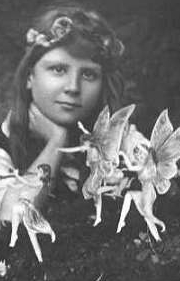 In 1917, two girls spent much of their summer playing by a stream. Repeatedly scolded for returning home wet and muddy, they said that they were playing with fairies. To prove it, they borrowed a camera and returned claiming that they had proof. That photo is shown here.
In 1917, two girls spent much of their summer playing by a stream. Repeatedly scolded for returning home wet and muddy, they said that they were playing with fairies. To prove it, they borrowed a camera and returned claiming that they had proof. That photo is shown here.
A total of five photos were taken over several years. The fairies were called the Cottingley fairies after Cottingley, England, the town where the girls lived.
A relative showed two of the photos at a 1919 public meeting of the Theosophical Society, a spiritualist organization. From there, Sir Arthur Conan Doyle, a devotee of spiritualism, took the baton. He wrote a 1920 article in The Strand Magazine that made the photos famous. To his credit, Conan Doyle asked experts to critique the photos. The opinions were mixed, but he decided to go with the story anyway.
Spiritualism, the popular belief that we can communicate with the spirits of the dead, was waning at the time of the article. Magician Harry Houdini, annoyed by fakers using tricks to defraud the gullible, devoted much time to debunking psychics and mediums in the 1920s until his death in 1926.
Houdini and Conan Doyle had been friends, but the friendship failed because of their opposite views on spiritualism. Conan Doyle believed that Houdini himself had supernatural powers and was using them to suppress the powers of the psychics that he debunked.
Research in 1983 exposed details of the Cottingley hoax, and the two principles finally admitted that they had faked the fairies by using cardboard cutouts of drawings copied from a book.
I learned of a modern parallel to this hoax at The Amazing Meeting in 2004. James Randi told the story of Project Alpha, during which he planted two fake psychics (Steve Shaw and Michael Edwards, actually talented amateur magicians) in the McDonnell Laboratory for Psychical Research in 1979. Randi contacted the researchers before planting his fakes to caution them how to avoid being deceived. The advice was thorough and genuine, and if they’d followed it, they would have uncovered the trickery.
Two years later, after the lab’s successes were well known within the psychic community and the fake psychics were celebrities, the deception was made public. The press was so bad that the McDonnell laboratory shut down.
The moral of the story: unless you’re a magician, don’t pretend that you can expose a magician. Said another way, just because you’re smart (and let’s assume both that the researchers were smart and most skeptics are smart), don’t think that you can’t be duped. This was Conan Doyle’s failing.
Magician Ricky Jay said, “The ideal audience would be Nobel Prize winners. … They often have an ego with them that says, ‘I am really smart so I can’t be fooled.’ No one is easier to fool.”
If you believe in the existence of fairies at the bottom of the garden,
you are deemed fit for the [loony] bin.
If you believe in parthenogenesis, ascension, transubstantiation and all the rest of it,
you are deemed fit to govern the country.
— Jonathan Meades
Photo credit: Wikimedia
Related posts:
- See all the definitions in the Cross Examined Glossary.
Related links:
- Paul Hoffman, “Why Are Smart People Some of the Most Gullible People Around?” Discover, 2/10/11.
- “Cottingley Fairies,” Wikipedia.
- “The Derbyshire Fairy,” Museum of Hoaxes.
- Emma Clayton, “Photographic expert uncovered hoax after testing cameras used by Cottingley cousins,” Telegraph & Argus, 11/17/10.
